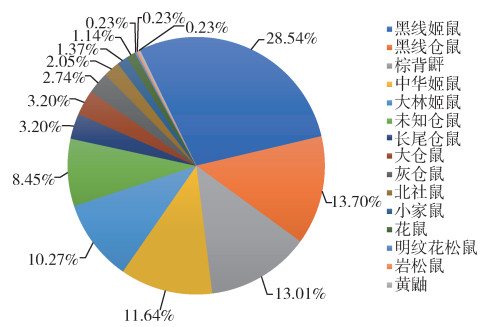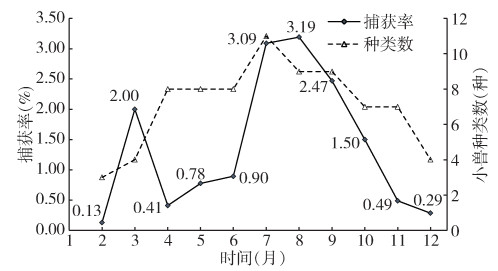扩展功能
文章信息
- 陈永明, 康东梅, 杜国义, 闫东, 刘冠纯, 周松, 郑楠, 兰晓宇, 杨爱, 马勇, 张晓磊, 温林, 孙飞, 王晓燕
- CHEN Yong-ming, KANG Dong-mei, DU Guo-yi, YAN Dong, LIU Guan-chun, ZHOU Song, ZHENG Nan, LAN Xiao-yu, YANG Ai, MA Yong, ZHANG Xiao-lei, WEN Lin, SUN Fei, WANG Xiao-yan
- 第24届冬奥会张家口赛区2018—2021年野外小兽类调查结果分析
- Investigation of small mammals from 2018 to 2021 in the Zhangjiakou competition zone of the 24th Olympic Winter Games
- 中国媒介生物学及控制杂志, 2022, 33(2): 293-296
- Chin J Vector Biol & Control, 2022, 33(2): 293-296
- 10.11853/j.issn.1003.8280.2022.02.024
-
文章历史
- 收稿日期: 2021-12-31
2 张家口市疾病预防控制中心, 河北 张家口075000;
3 张家口市地方病防治所, 河北 张家口 075000;
4 崇礼区疾病预防控制中心, 河北 张家口 076350
2 Zhangjiakou Center for Disease Control and Prevention, Zhangjiakou, Hebei 075000, China;
3 Zhangjiakou Institute of Endemic Diseases Control and Prevention Zhangjiakou, Hebei 075000, China;
4 Chongli Center for Disease Control and Prevention, Zhangjiakou, Hebei 076350, China
崇礼区是第24届冬奥会张家口赛区的赛事举办地,太子城区域是奥运核心区。在京张高铁崇礼铁路、奥运村、古杨树场馆群等冬奥重点项目开展时,为了做好防疫保障等医学应急工作,确保奥运赛事的安全举办,我们自2018年9月开始,对赛事场地周边环境及整个崇礼区环境鼠类进行为期4年的监测和调查工作。本文对2018年9月—2021年5月的监测结果进行总结分析,通过监测,基本摸清了奥运会现场可能的病媒生物威胁,为下一步防控工作打下了坚实的基础。
1 材料与方法 1.1 调查方法2018年9月—2021年5月,每月调查1次。每次随机选择6~8个样点,每个样点根据生境或海拔高度不同,选择1~2种有代表性的生境,每种生境布放鼠夹100夹;2个样点之间距离 > 200 m,在山区垂直距离 > 50 m;以花生米为诱饵,采用5 m夹线法布放鼠夹,晚放晨收,在布夹时间内遇到风雨时,不计算捕获率[1-3]。调查范围涉及崇礼区全区的2镇8乡。
1.2 数据分析 1.2.1 数据统计应用Excel 2010软件对小兽类调查数据进行整理和逐年逐月统计并绘制图表,运用集中度法对小兽类及其种类季节分布特征进行分析,通过绘制散点图,探索小兽类捕获率与小兽种数之间是否有直线趋势,若有,并做线性相关分析,P < 0.05有统计学意义。其中:
| $ \mathrm{捕}\mathrm{获}\mathrm{率}=\frac{\mathrm{捕}\mathrm{获}\mathrm{小}\mathrm{兽}\mathrm{数}(\mathrm{只})}{\mathrm{布}\mathrm{夹}\mathrm{数}(\mathrm{夹})}\times 100\mathrm{\%} $ |
集中度(M)说明传染病的群体现象在1年中的集中程度。M值为1时,表示最大极限,说明1年内的疾病总数集中在1个月内;M值为0时,表示最小极限,说明1年内的疾病总数均匀分布在12个月内;M≥0.9时,说明疾病有严格的季节性;0.7≤M值< 0.9,说明疾病有很强的季节性;0.5≤M值< 0.7,说明疾病有较强的季节性;0.3≤M值< 0.5,说明疾病有一定的季节性;M值< 0.3,说明疾病的时间分布比较均匀。
| $ {R}_{x}=\frac{1}{2}\left({r}_{2}+{r}_{6}-{r}_{8}-{r}_{12}\right)+\frac{\sqrt[]{3}}{2}\left({r}_{3}+{r}_{5}-{r}_{9}-{r}_{11}\right)+\left({r}_{4}-{r}_{10}\right) $ |
| $ {R}_{y}=\frac{1}{2}\left({r}_{3}-{r}_{5}-{r}_{9}+{r}_{11}\right)+\frac{\sqrt[]{3}}{2}\left({r}_{2}-{r}_{6}-{r}_{8}+{r}_{12}\right)+({r}_{1}-{r}_{7}) $ |
| $ M=\sqrt[]{{R}_{x}^{2}+{R}_{y}^{2}} $ |
式中,M表示集中度,r表示某月捕获小兽数与其全年捕获小兽数总和之比,下角标表示月份,R表示离散度。
2 结果 2.1 崇礼区调查结果概述在崇礼全区采用5 m夹线法共计调查样点336个,布放鼠夹33 610夹次,捕获小兽类(其中含黄鼬1只,其余均为鼠类,为方便描述,以下简称鼠类)438只,总捕获率为1.30%,隶属于4科9属12种,未知仓鼠37只,有待于进一步进行分子生物学鉴定。其中黑线姬鼠(Apodemus agrarius)125只,占28.54%,为优势鼠种;其次是黑线仓鼠(Circetulus barabensis),占比为13.70%,再次是棕背䶄(Myodes rufocanus),占比为13.01%(图 1)。其中奥运场馆及奥运村周边地区4年共计捕获鼠类8种,优势鼠种仍然为黑线姬鼠。

|
| 图 1 第24届冬奥会张家口赛区崇礼区2018—2021年野外小兽种类构成 Figure 1 Composition of wild small mammals species from 2018 to 2021 in Chongli district of the Zhangjiakou competition zone of the 24th Olympics Winter Games |
| |
2018—2021年崇礼区捕获野外鼠类密度最高的年份是2019年,捕获率为2.09%,其次是2018年,捕获率为1.84%,再次是2020年,捕获率为1.11%,最低的是2021年捕获率仅为0.36%;其中奥运场馆及奥运村周边地区鼠密度呈下降状态,2021年密度最低,为0.57%。而鼠种类最多的年份是2020年,达12种,最少的是2018年,仅6种;从年份分布来看,鼠密度与鼠种之间无相关性。从季节分布规律来看,鼠密度有较强的季节性(M=0.58),呈双峰型,其中春季(1—3月)的3月为第1个高峰,秋季(7—9月)的8月为第2个高峰,且后峰明显高于前峰;鼠种数分布有一定的季节性(M=0.31),呈单峰型,随着季节变化鼠种数逐渐增多,到7月达到峰值,为11种,然后又逐渐下降,至12月仅有4种鼠。见图 2。

|
| 图 2 第24届冬奥会张家口赛区崇礼区2018—2021年野外小兽类密度和种类数季节性变化趋势 Figure 2 Seasonal changes in small mammals density and species from 2018 to 2021 in Chongli district of the Zhangjiakou competition zone of the 24th Olympic Winter Games |
| |
崇礼区海拔从814 m延伸至2 174 m,根据李炳元等[6]等将我国地貌海拔划分为5个等级的标准,分别在低海拔(< 1 000 m)、中海拔(1 000~2 000 m)和亚高海拔(2 000~4 000 m)进行调查。鼠密度随着海拔的升高而增高,捕获率分别是0.22%、1.06%、2.00%;然而鼠种以中海拔地区居多,为10种,其次是亚高海拔地区(4种)、低海拔地区(3种),且仓鼠属主要分布在低海拔和中海拔地区,亚高海拔地区未见,姬鼠属主要分布在中海拔和亚高海拔地区,低海拔地区未见。
在崇礼区开展监测的生境有草坡、山坡、荒坡、河滩、林带、耕地、草滩、铁道旁及雪场滑雪道旁,其中密度最高的是草滩,捕获率为1.86%,其次是耕地,捕获率为1.68%,以雪场滑雪道旁密度最低,未捕获鼠类(图 3)。鼠种变化以草滩和林带最为丰富,均为12种,其次是山坡、草坡、荒坡和耕地,为8~10种,而铁道旁和河滩仅有2~4种。通过散点图研究发现,鼠密度与鼠种数在不同生境内有正相关趋势,进行线性相关分析发现r=0.823,P=0.006,在0.01水平上显著相关。

|
| 图 3 第24届冬奥会张家口赛区崇礼区2018—2021年野外小兽类密度和种类数在不同生境的分布 Figure 3 Distribution of small mammals density and species in different habitats from 2018 to 2021 in Chongli district of the Zhangjiakou competition zone of the 24th Olympic Winter Games |
| |
啮齿类动物是全世界分布最广泛的哺乳类动物,全世界约有2 700种,约占哺乳动物的43.74%。我国约有200多种啮齿类动物。目前发现啮齿目动物体内存在30余种高致病性病毒,如冠状病毒、沙粒病毒、布尼亚病毒、黄病毒及小RNA病毒等[7];啮齿动物能传播30多种疾病,其中危害严重的有鼠疫、肾综合征出血热(HFRS)、钩端螺旋体病和恙虫病等,其中鼠疫是我国甲类传染病,有53种啮齿类动物可以感染鼠疫耶尔森菌[8-9]。啮齿动物作为哺乳动物占比最大的部分,携带多种与人类关系密切的病毒和细菌,对人类危害较大,掌握啮齿动物的分布、进一步研究其所携带的病毒和细菌,对疾病防治有极其重要的意义。
崇礼区位于张家口北部,北倚内蒙古高原,距离张家口市50 km,距离北京市220 km。属于中温带半干旱大陆季风气候,境内以山地居多,约占80%,海拔从814 m延伸至2 174 m,年平均降水量为477 mm,降雨主要集中在6—9月,年平均气温3.9 ℃。该区缺乏相关病媒生物的基础数据,闫东等[10]研究发现黑线姬鼠是本地区的优势鼠种,与本研究结论相符。通过研究发现,崇礼区鼠密度有2个高峰期,分别是春季和秋季,其中后者高于前者,且高鼠密度区域主要分布在亚高海拔地区,而鼠种类最为丰富的却是中海拔地区,崇礼区发现的所有鼠种几乎均可在中海拔区见到;另外,包括鼠疫次要宿主黑线仓鼠在内的仓鼠属主要分布在低海拔和中海拔地区,亚高海拔地区未见,包括HFRS宿主动物黑线姬鼠、大林姬鼠(A. eninsulae)等在内的姬鼠属主要分布在中海拔和亚高海拔地区,低海拔地区未见。在监测生境中,草滩、耕地、林带和山坡的鼠密度高、鼠种类较为丰富。因此,建议今后应特别关注中高海拔地区鼠类种群变化,特别是草滩、耕地、林带及山坡等地区的种群结构的变化,时刻关注鼠源性疾病[11]在该地区的流行风险。
对奥运场馆及奥运村周边地区连续4年进行监测发现,鼠密度虽呈下降趋势,但优势鼠种为黑线姬鼠,该鼠是HFRS的主要宿主动物,而与崇礼相毗邻的承德市存在HFRS疫源地[12]。因此,应持续关注黑线姬鼠密度变化,并对其进行相应病原体监测,为第24届冬奥会及冬残奥会的安全、顺利进行保驾护航。
利益冲突 无
| [1] |
孙养信, 白江春, 范锁平, 等. 陕西省鼠疫疫区夜行鼠生态学调查[J]. 中国媒介生物学及控制杂志, 2008, 19(3): 224-227. Sun YX, Bai JC, Fan SP, et al. Investigation on the ecology of nocturnal rodents in plague epidemic area, Shaanxi province[J]. Chin J Vector Biol Control, 2008, 19(3): 224-227. DOI:10.3969/j.issn.1003-4692.2008.03.016 |
| [2] |
马勇, 闫东, 史献明, 等. 河北省鼠疫监测区2007-2016年鼠类种群变迁研究[J]. 中国媒介生物学及控制杂志, 2018, 29(2): 189-190, 193. Ma Y, Yan D, Shi XM, et al. Study on the change of rodent populations in plague surveillance areas of Hebei province[J]. Chin J Vector Biol Control, 2018, 29(2): 189-190, 193. DOI:10.11853/j.issn.1003.8280.2018.02.019 |
| [3] |
闫东, 史献明, 崔耀仁, 等. 河北省鼠疫疫源地小型夜行鼠调查[J]. 中国媒介生物学及控制杂志, 2011, 22(4): 375-377. Yan D, Shi XM, Cui YR, et al. Investigation of small nocturnal rodents in a natural plague focus in Hebei province[J]. Chin J Vector Biol Control, 2011, 22(4): 375-377. |
| [4] |
郭祖超. 医用数理统计方法[M]. 3版. 北京: 人民卫生出版社, 1988: 843-857. Guo ZC. Medical mathematical statistics[M]. 3rd ed. Beijing: People's Medical Publishing House, 1988: 843-857. |
| [5] |
金丕焕. 医用统计方法[M]. 2版. 上海: 复旦大学出版社, 2003: 89-92. Jin PH. Medical statistical method[M]. 2nd ed. Shanghai: Fudan University Press, 2003: 89-92. |
| [6] |
李炳元, 潘保田, 韩嘉福. 中国陆地基本地貌类型及其划分指标探讨[J]. 第四纪研究, 2008, 28(4): 535-543. Li BY, Pan BT, Han JF. Basic terrestrial geomorphological types in China and their circumscriptions[J]. Quat Sci, 2008, 28(4): 535-543. DOI:10.3321/j.issn:1001-7410.2008.04.004 |
| [7] |
苏航, 徐春雨, 贾修岐, 等. 啮齿目动物携带病毒的研究进展与展望[J]. 生物化工, 2021, 7(1): 123-126. Su H, Xu CY, Jia XQ, et al. Advances and prospect for rodents carry viruses researches[J]. Biol Chem Eng, 2021, 7(1): 123-126. DOI:10.3969/j.issn.2096-0387.2021.01.033 |
| [8] |
刘振才, 程治国, 张雁冰, 等. 我国鼠疫自然疫源地染疫动物种类及其分布[J]. 现代预防医学, 2002, 29(6): 768-770. Liu ZC, Cheng ZG, Zhang YB, et al. Type and distribution of animal of catching plague in the plague nature focis of China[J]. Mod Prev Med, 2002, 29(6): 768-770. DOI:10.3969/j.issn.1003-8507.2002.06.011 |
| [9] |
秦长育, 许磊, 张祖荣, 等. 中国鼠疫自然疫源地分型研究V. 鼠疫宿主生物学特征[J]. 中华流行病学杂志, 2012, 33(7): 692-697. Qin CY, Xu L, Zhang ZR, et al. Ecological-geographic landscapes of natural plague foci in China V. Biological characteristics of major natural reservoirs of Yesinia pestis[J]. Chin J Epidemiol, 2012, 33(7): 692-697. |
| [10] |
闫东, 陈永明, 孙飞, 等. 河北省张家口市冬奥会赛区和周边区域鼠类及其寄生蚤物种构成和分布调查[J]. 中国媒介生物学及其控制杂志, 2021, 32(4): 161-164. Yan D, Chen YM, Sun F, et al. An investigation of the species composition and distribution of rodents and their parasitic fleas in the Winter Olympic Games zone and surrounding areas in Zhangjiakou, Hebei province, China[J]. Chin J Vector Biol Control, 2021, 32(4): 161-164. DOI:10.11853/j.issn.1003.8280.2021.02.008 |
| [11] |
刘蓉蓉. 中国姬鼠属种类分子系统关系及其地理分布研究[D]. 北京: 中国疾病预防控制中心, 2017. Liu RR. Molecular phylogeny and geographical distribution of Apodemus species in China[D]. Beijing: China Center for Disease Control and Prevention, 2017. (in Chinese) |
| [12] |
韩旭, 魏亚梅, 许永刚, 等. 2013-2015年河北省肾综合征出血热流行特征分析[J]. 中国病原生物学杂志, 2018, 13(1): 76-78, 82. Han X, Wei YM, Xu YG, et al. Epidemiology of hemorrhagic fever with renal syndrome in Hebei province from 2013-2015[J]. J Pathog Biol, 2018, 13(1): 76-78, 82. DOI:10.13350/j.cjpb.180116 |
 2022, Vol. 33
2022, Vol. 33


